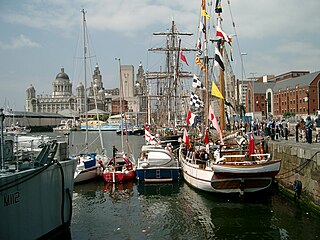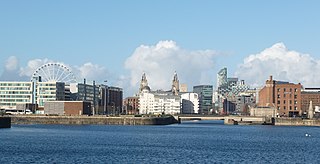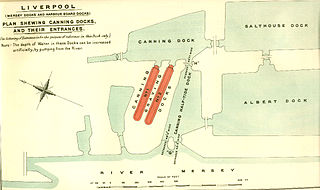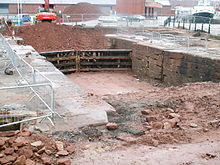
Canada Dock is a dock on the River Mersey, England, and part of the Port of Liverpool. It is situated in the northern dock system in Kirkdale. Canada Dock consists of a main basin nearest the river wall with three branch docks and a graving dock to the east. It is connected to Brocklebank Dock to the north and Huskisson Dock to the south.

Salisbury Dock is a dock on the River Mersey, England, and part of the Port of Liverpool. It is situated in the northern dock system in Vauxhall and is connected to Nelson Dock to the north, Trafalgar Dock to the south and inland to Collingwood Dock.

Collingwood Dock is a dock on the River Mersey, in England, and part of the Port of Liverpool. It is situated in the northern dock system in Vauxhall, and is connected to Stanley Dock to the east and Salisbury Dock to the west.

Trafalgar Dock is a dock on the River Mersey, in England, and part of the Port of Liverpool. It is situated in the northern dock system in Vauxhall and connected to Salisbury Dock to the north. The sites of two former docks are located in the vicinity; Victoria Dock was located to the south and Clarence Dock to the east.

Waterloo Dock is a dock on the River Mersey, England, and part of the Port of Liverpool. It is situated in the northern dock system in Vauxhall and connected to Princes Half Tide Dock to the south. The site of Victoria Dock is located to the north.

Prince's Dock is a dock on the River Mersey, England, and part of the Port of Liverpool. It is the most southerly of the docks situated in the northern part of the Liverpool dock system, connected to Prince's Half-Tide Dock to the north. The dock is now in the buffer zone to one of Liverpool's World Heritage Sites.

Canning Dock on the River Mersey is part of the Port of Liverpool in Northern England. The dock is in the southern dock system, connected to Salthouse Dock to the south and with access to the river via the Canning Half Tide Dock to the west. The Canning Graving Docks are accessed from the dock.

Salthouse Dock is a dock on the River Mersey, England, and part of the Port of Liverpool. It is situated in the southern dock system, connected to Canning Dock to the north, Wapping Dock via Wapping Basin to the south and Albert Dock to the west.

Wapping Dock is a dock on the River Mersey, England, and part of the Port of Liverpool. It is situated in the southern dock system, connected to Salthouse Dock to the north, Queen's Dock to the south. King's Dock was originally located to the west, but has since been filled in.

Queen's Dock is a dock on the River Mersey and part of the Port of Liverpool. It is situated in the southern dock system, connected to Wapping Dock to the north and Coburg Dock to the south.

Coburg Dock is a dock on the River Mersey, in England, and part of the Port of Liverpool. It is situated in the southern dock system, connected to Queens Dock to the north, Brunswick Dock to the south.

Brunswick Dock is a dock on the River Mersey, in England, and part of the Port of Liverpool. It is situated in the southern dock system, connected to Coburg Dock to the north, Toxteth Dock to the south.

Harrington Dock was a dock on the River Mersey and part of the Port of Liverpool. Situated in the southern dock system, it was connected to Toxteth Dock to the north and Herculaneum Dock to the south.

Duke's Dock is a dock on the River Mersey, England, and part of the Port of Liverpool. It is in the southern dock system, connected to Salthouse Dock and Wapping Dock to the east. The Albert Dock is located immediately north, although not directly accessible by water.

Canning Half Tide Dock on the River Mersey, in Liverpool, England, is a half tide dock and is part of the Port of Liverpool. It is situated in the southern dock system, connected to Canning Dock to the east and Albert Dock to the south.

George's Dock was a dock, on the River Mersey, England, within the Port of Liverpool. It was connected to Canning Dock to the south and George's Basin to the north.

The Great Float is a body of water on the Wirral Peninsula, England, formed from the natural tidal inlet, the Wallasey Pool. It is split into two large docks, East Float and West Float, both part of the Birkenhead Docks complex. The docks run approximately 2 miles (3 km) inland from the River Mersey, dividing the towns of Birkenhead and Wallasey. The Great Float consists of 110 acres (45 ha) of water and more than 4 miles (6 km) of quays.

The Liverpool Canal Link is an English waterway link that connects the Leeds and Liverpool Canal, at the Liverpool Pier Head, to the city's South Docks. It cost £22m and was opened in March 2009. The new link adds 1.4 miles (2.3 km) of navigable waterway to the canal system.

Sandon Dock was a dock on the River Mersey, England, and part of the Port of Liverpool. Situated in the northern dock system, it was east of Sandon Half Tide Dock, to which it was once connected.

Chester Basin was a tidal basin on the River Mersey, in Liverpool, England. The basin was situated between the Pier Head and Manchester Dock.






















